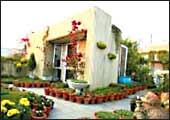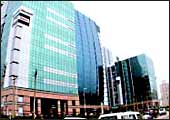 |
| Appreciation in residential property
prices in big cities is slowing down |
Ceejay house in up-market
Worli in central Mumbai is a swank, mint-new, 11-storey commercial
structure. Till recently, the going rate for rentals here was around
Rs 300 per square foot per month, making it one of the most expensive
office spaces in the financial capital. A clutch of Wall Street
banks had lined up to purchase offices at Ceejay. In a few months
the asking rate duly zoomed to Rs 450 per square foot per month.
That meant an area of 30,000 square feet, which is what at least
one of the investment banks was looking for, would command a price
tag of a cool Rs 1.3 crore per month. Now investment bankers are
no doubt making money hand over fist, but they're also quick to
spot a bum deal. According to those familiar with the Mumbai property
market, two of the Wall Street firms have backed out from their
respective transactions after the 33 per cent spurt in Ceejay's
rentals.
Cut to Whitefield, the technology nerve centre of Bangalore,
where rentals have plateaued over the past three months. At Rs
27 per square foot per month, the appreciation over a year is
just 17 per cent. What's more, the buying rate for commercial
property is the same as what prevailed a year ago-Rs 2,300 per
square foot. Now remember Whitefield is home to the International
Technology Park, and to some of the biggest names in the information
technology sector, like AOL and IBM to name just two.
It's been party time for the property pashas of Punjab. Prices
of commercial plots have doubled over the past 24 months. Plots
in Chandigarh measuring 500 square yards, which could be bought
for Rs 50-60 lakh each three years ago, had shot up to Rs 3 crore
by early 2006. Those prices have now cooled off a bit to Rs 2.4
crore. In Mohali, residential plots with an area of 500 square
yards, which were going for Rs 1.7 crore a year ago, are down
to Rs 1.5 crore. Similarly, a 250 square yard plot which was quoting
at Rs 95 lakh a year ago is down to Rs 80 lakh today.
| SCAM IN THE
SLUM? |
| The stakes in Mumbai's ghetto rehabilitation
exercise are akin to prices in upscale South Mumbai-high. |
| If developers in Mumbai continue to expect
heady prices for their constructions, it's simply because
of the sheer demand for space-residential, commercial and
retail-in the chock-a-block commercial capital. Creating more
spaces to accommodate more supply is the need of the day,
and it's here that slum rehabilitation could prove a major
determinant of future price trends. Mumbai's Dharavi area-the
largest slum in Asia-occupies an area of 535 acres, almost
all of it prime property in the heart of the city. Slums in
Mumbai are estimated to occupy around 60 per cent of the city's
land. Given the high stakes involved, the entire exercise
somewhat predictably has degenerated into a scam, with a section
of builders reportedly claiming ownership to some slums in
Mumbai. The rules of the Slum Rehabilitation Authority (SRA)
specify that a builder who is interested in developing slum
land will necessarily have to get the consent of at least
70 per cent of the slum residents. The tricky part is in rehabilitating
the residents and what can be done with the surplus land.
The normal process entails providing affordable housing to
the slum residents and charging higher rates from the surplus
land which normally has better housing. Media reports have
suggested a nexus between the builders and the government.
According to eminent Mumbai architect, Hafeez Contractor,
it is important to provide more slum housing. "If there
are 50 people living in the slums, it is important to create
housing for at least three times that number," he states.
In his opinion, the important thing is to employ the land
in a more productive manner. "If you have 10,000 acres
of land out of which half is housed in a salt pan, it is
necessary to increase the floor space index (FSI) on the
balance 5,000 acres," adds Contractor.
The environmentalists have a different point of view.
Debi Goenka, who heads the Bombay Environment and Action
Group (BEAG) thinks the present policy of slum rehabilitation
is not the right approach. "The policy rewards people
who are breaking the law and it appears to be a political
move. Mumbai's slums are just vote banks and are never a
priority," he says. Goenka adds that the policy will
have to be corrected to the extent where a free house cannot
be given to an encroacher.
With 350 families estimated to be entering the city every
day, affordable housing is critical. At the same time, the
city boasts a super-rich elite whose appetite for upscale
housing is still not sated. "It is hard to imagine
what will happen to Mumbai's housing when the city's population
hits a figure like 30 million (from the current 16 million),"
shudders Contractor.
|
 |
| Commercial property rates also
haven't gone up sharply in the past one year |
Wake up, step outside and take a good look around. Such signs of
cooling off in property prices might just be wafting around in that
skyscraper being raised in your backyard. Or in that office space
for which you're poised to sign on the dotted line. Worli, Whitefield
and Chandigarh aren't just aberrations or stray pockets of inactivity
in what was till recently an all-embracing manic property market.
After three-four years of stunning gravity-defying appreciation,
prices of residential and commercial real estate are pausing for
breath. Consider some more random examples from across the country:
Residential property rates on Delhi's Prithviraj Road and Aurangzeb
road are 46 per cent higher than they were a year ago. However,
for the past six months those rates haven't budged an inch. Similarly,
the average value of homes in Friends Colony and Maharani Bagh is
up 104 per cent in a year. The appreciation over the past six months?
Just 5 per cent. Move on to Bangalore, where the rates per square
foot in the areas of Malleshwaram, Rajajinagar, Jayanagar and Koramangala
are up by just 2-6 per cent over the past three months. Even in
the financial capital Mumbai, the appreciation in tony South Mumbai
is subdued, from 30 per cent-plus levels a year ago to a modest
13 per cent over the past six months. The slowdown is more visible
in the commercial sector, with sale prices in suburban areas like
Bandra-Kurla, Andheri and Powai stagnating over the past three months.
In Bangalore and Kolkata too demand for office space has slowed
to a virtual crawl in the past three months.
 |
| Property prices have cooled off
a bit in smaller cities too |
Don't panic: There's no crash waiting to happen. Not yet. But across
the country there are investors, financiers and developers who've
been caught off guard, as liquidity and appreciation are no longer
everyday companions to cosy up with. To use the 'greater fool's
theory', there would be many investors out there looking to pass
off their overvalued asset to an even more ravenous speculator-the
greater fool-at a higher price. The greatest fool will of course
be the guy who can't find a sucker onto whom he can palm off the
asset at an even higher price. And that's when the bubble will burst.
"Prices in the real estate sector are at their peak. We have
already seen a slight dip in the demand and some softening of prices
in select pockets such as Whitefield, Noida and Ghaziabad. A combination
of prevailing prices in the real estate sector and rising interest
rates will see some investors exit the market," says Renu Sud
Karnad, Executive Director, HDFC.
 |
"A combination
of prevailing prices in the real estate sector and rising
interest rates will see some investors exit the market"
Renu Sud Karnad/Executive Director/HDFC |
Many such investors would be looking for bail-out options in the
North Indian cities of Ludhiana, Chandigarh and Jaipur where, real
estate consultants point out, prices are in the over-valued zone.
In Ludhiana, for instance, where at least 10 malls are in various
stages of construction, commercial property rates have soared from
around Rs 1,700 per square foot two years ago to Rs 4,000 per square
foot-to put that in perspective, that's the going rate in Bangalore's
bustling Koramangala and Indiranagar districts, and in Navi Mumbai's
it hub! "In cities like Ludhiana and Chandigarh I expect a
correction over the next three-six months, which will be to the
extent of 10-15 per cent," says Anuj Puri, Managing Director,
Trammell Crow Meghraj Property Consultants. Puri adds that speculation
accounts for at least half the property-related transactions in
that part of north India, which has resulted in prices rocketing
to bizarre levels.
 |
"While
a price increase of 5-10 per cent yearly can be absorbed,
it may not be desirable to have something higher than that"
Rajiv Sabharwal/Head (Retail Assets)/ICICI Bank |
S. Sriniwasan, CEO, Kotak Realty Fund, points out that the appreciation
in some parts of India was too quick for comfort. "Certain
micro-markets have got over-heated. Among these are the satellite
towns in North India and Bangalore's it parks," he says.
One reason for that is that supply in such regions has inevitably
raced ahead of demand. That's clearly the situation in Whitefield.
"Whitefield was one of the most sought after locations a
couple of years ago but an oversupply of realtors has led to a
price slump," says Sushil Mantri, Managing Director, Mantri
Developers. Purvankara Projects is a developer with a large exposure
to Whitefield. Director Ravi Ramu anticipates a shakeout among
developers in this district.
It isn't as if the era of over-exuberance is over. In the most
expensive market, Mumbai-also the fifth most expensive city in
the world for office space-profits booked on the stock market
duly find their way into property. And the graph keeps heading
northward in upscale south Mumbai. On Altamount Road, prices have
hit the Rs 50,000 per square foot mark, and in Tardeo in central
Mumbai duplex apartments measuring 10,000 square feet are in the
market for Rs 45 crore, which is the annual net profit of a mid-cap
company like Geodesic Information Systems and basf India! "The
cost of residential housing is typically 3-4 years of the gross
earnings of a person. Today, it is at least 6-7 times," says
Pranay Vakil, Chairman, Knight Frank India, a Mumbai-based real
estate consultancy. At the top end (properties in the Rs 15 crore
and above bracket), the cost would work out to 15-20 times an
individual's gross earnings.
 |
 |
"The real estate
sector is heated today. Banks would have to take a holistic
perspective towards the sector and should be cautious"
Jitender Balakrishnan/Deputy Managing Director/IDBI Bank |
"There
is a continuous growth in demand in the principal cities and
people will continue to pick up property"
Niranjan Hiranandani/Managing Director/Hiranandani
Constructions |
It's such rampant mania that's making lenders cautious. The home
finance majors, for their part, have slipped into conservative
mode (80 per cent of real estate demand is from the residential
sector). "A sharp increase in real estate prices is the biggest
worry for a lender. We evaluate a borrower on his current income
and we have been conservative on loan to value over the last 1-2
years," points out ICICI Bank's Head- Retail Assets, Rajiv
Sabharwal. "While a price increase of 5-10 per cent yearly
can be absorbed, it may not be desirable to have something higher
than that. The more important thing is to increase the supply
of land," he adds.
Making it easier for supply to race ahead of demand is sobered-down
demand itself, a direct outcome of rising interest rates and tighter
liquidity conditions. "Rising interest rates is a cause of
concern for the real estate market. Sales have definitely reduced
in many locations across many cities in the country. Though the
developers in most of the locations have held on to the rates,
the rate of appreciation has reduced and may further go down if
the mortgage rates continue to increase," says HDFC's Karnad.
She adds that the land appreciation in many cities is unhealthy
for the market. "The Reserve Bank of India (RBI) has discouraged
land funding which is expected to reduce liquidity in land transactions.
We expect the land prices to stabilise and in some locations to
fall in the near future which will be good for the market in the
long-run," she adds.
 |
 |
"In cities
like Ludhiana and Chandigarh, I expect a correction over the
next three-six months that will be to the extent of 10-15
per cent"
Anuj Puri/MD/Trammell Crow
Meghraj Property Consultants |
Architect Hafeez Contractor:
It is important to provide more slum housing |
The RBI's cautious approach on the sector is now well-known.
It is precisely because of the speculative flavour of the real
estate industry that the RBI specified recently that finance companies
accepting public deposits will not be allowed to invest more than
10 per cent of their net worth in land or property except for
their own use. "The real estate sector is heated today. Banks
would have to take a holistic perspective towards the sector and
should be cautious," says Jitender Balakrishnan, Deputy Managing
Director, IDBI Bank.
An early-on indicator of the correction that's begun to take
place is the bear hug on real estate stocks which, on an average,
are down by around 50 per cent from their all-time highs (see
The Higher They Rise...). Finance Minister P. Chidambaram's budgetary
proposals didn't provide much joy, with property stocks tanking
by around 10 per cent two days after the announcement. Differential
rates of excise duty on cement coupled with the sub-contractor
not being entitled to section 80 1A/1B benefits is seen as a dampener
for the construction/infrastructure industry, according to Seemanta
Roy, Head Amby Valley City & Entertainment Business of Sahara
Pariwar. What's more, he adds that in cities like Mumbai where
rentals for commercial property are as high as Rs 350 per square
foot per month, a service tax of 12.36 percent could well prove
to be the proverbial straw that breaks the camel's back.
 |
 |
"The cost of residential
housing is typically 3-4 years of the gross earnings of a
person. Today, it is at least 6-7 times"
Pranay Vakil/Chairman/Knight Frank India
|
"Whitefield
(Bangalore) was one of the most sought after locations a couple
of years ago. But an oversupply of realtors has led to a price
slump"
Sushil Mantri/Managing Director/Mantri Developers
|
The picture may not that be that bleak. Demand is not exactly
non-existent, and CRIS-INAFAC report on real estate construction
points out that the sector will average 5 per cent growth cumulatively
between fiscal 2006 and 2008. Developers, for their part, are
still full of beans. "There is a continuous growth in demand
in the principal cities and people will continue to pick up property,"
argues Niranjan Hiranandani, Managing Director, Hiranandani Constructions,
who adds that prices in Mumbai are still on the rise. In some
non-metros too, there would appear to be some headroom left. The
Bangalore-based Brigade Group is offering deluxe apartments in
Mysore at over Rs 1 crore. "With a new airport on the anvil
and overall connectivity being enhanced, Mysore could be the next
big real destination," thinks Brigade Group's Managing Director,
M.R. Jaishankar. Yet, analysts point out that Mumbai and Mysore
aren't the best examples of markets dominated by speculators.
It isn't as if the entire Indian real estate market is overheated,
but certainly there are some crucial pockets that need to be cooled
off. As IDBI Bank's Balakrishnan puts it: "It's not a bubble
yet, but we cannot allow it to become one." In many parts
of India the greatest fool may be just a couple of transactions
away.
-additional reporting by Amit
Mukherjee, Rahul Sachitanand and Nitya Varadarajan
|















